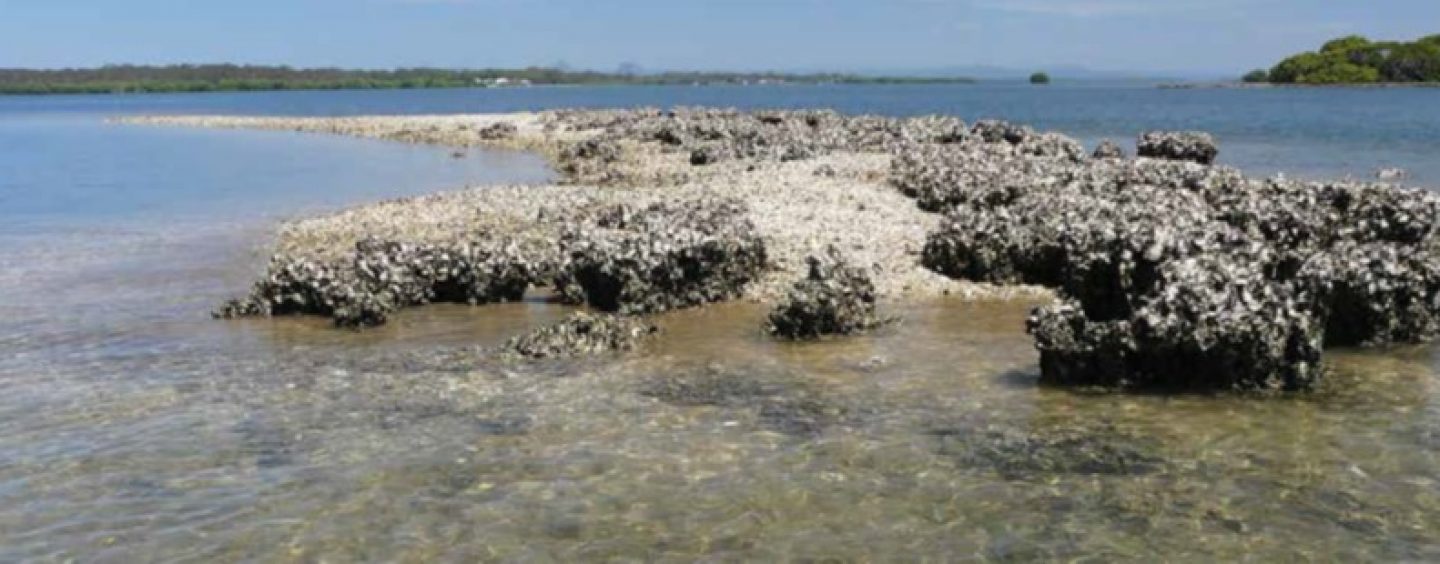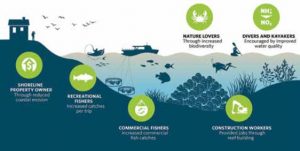By Roselle Tenefrancia
While shellfish, such as oysters and mussels, are popular seafood delicacies all over the world, they are also known to form shellfish reefs. These reefs are complex living structures that provide ecosystem services, such as food provision, habitat for fish and invertebrates, water filtration, fish production and shoreline protection. With their function, shellfish reefs are “the kidneys” of healthy estuaries.
According to Steyn (2021), shellfish can be found worldwide, but certain types of shellfish tend to aggregate in large groups, forming shellfish reefs. These structures are formed by millions of oysters or mussels clustering together in bays, estuaries and nearshore waters. They are like coral reefs, as they provide shelter and food for many other species.
COMMUNITY BENEFITS OF SHELLFISH REEFS
Shellfish reefs are complex, three-dimensional living structures, which provide food, shelter and protection for a range of other invertebrate and fish species. These reefs form in bays, estuaries and nearshore coastal waters in both tropical and temperate regions across every state within Australia.
* Every hectare of oyster reef (per year) would filter 2.7 billion litres of seawater,
remove 225 kg of nitrogen and phosphate, produce 375 kg of new fish to
catch and eat. Provide new homes for over 100 marine species, and prevent
7,000m3 of used shell from entering local landfill. (The Nature Conservancy)
SHELLFISH REEFS IN AUSTRALIA
Shellfish ecosystems once occupied large areas of coastal waters in Australia in both temperate and tropical regions, but have been lost or severely diminished by over 85% globally by overfishing, dredging, water pollution and disease. (Department of Environment and Science, Queensland [2022] Shellfish reefs, WetlandInfo website, accessed 24 February 2023)
According to the research of Nature Conservancy Australia, Australia’s southern coastline about 200 years ago was full of oyster reefs and mussel beds stretching from Noosa to Perth — quietly keeping our coastal waters clean and clear, safeguarding coastlines and acting as nursery grounds for fish. However, reefs were decimated by years of commercial harvesting of wild shellfish, water pollution, introduced species and disease. The results of the research showed that fewer than 8% of shellfish reefs remain, contributing to decline in water quality, coastal protection, and loss of fish and other marine life on our coastal waters.
Research scientists at James Cook University have indicated that shellfish reefs are the country’s most threatened ecosystem. They said that much of the destruction occurred during the 1800s and early 1900s due to overfishing, habitat modification, disease outbreaks, invasive species and a decline in water quality. They further stated that the degradation contributed to the release of stored carbon, worsening climate change and increasing coastal risks associated with more frequent and intense storms, sea level rise and ocean acidification. (Phys.org, 2018)
Up until the turn of the last century, Moreton Bay supported magnificent intertidal and subtidal shellfish beds which had always been a valuable food and cultural resource for First Nations people living in the region.
The oyster industry was the foremost industry carried on in the early days of Moreton Bay’s history and local development. But the oysters were used for a variety of purposes. Queensland’s early roads were made of shell from midden heaps, and the live and dead oysters were thrown into the lime burners for cement. It did not take long for overharvesting, disease and water pollution to deplete the shellfish stocks to the point where they are now functionally extinct in Pumicestone Passage. (Healthy Land and Water)
WHY SHELLFISH REEFS ARE IMPORTANT
Shellfish reefs are considered ecosystem engineers, building complex habitats, protecting nearshore communities from storms by forming natural breakwaters, and even cleaning up after themselves.
They provide habitat for other species by creating a hard substrate with high surface complexity, acting as attachment sites for sessile organisms and refuges for mobile organisms, supporting high levels of species diversity. They function just like the more colourful coral reefs, providing food and habitat for fish and other marine life. They provide crevices that fish and crabs use to hide from predators. They are also good habitat for smaller forage species.
Besides being food, oysters in particular make waters healthier. They feed by filtering algae from the water, functioning as a natural filter that helps improve water that is overloaded with nutrients. In ideal conditions, it has been found that one oyster can filter up to more than 189 litres of water per day. With cleaner and clearer water, seagrasses are supported, creating a stable habitat for juvenile crabs, scallops and fish.
In some locations, oyster reefs can protect underwater vegetation and waterfront communities from some effects of waves, floods and tides. Well-established grass beds can help stabilise the seabed, providing resilience against wave action. These reefs may also help in reducing wave energy, prevent erosion, and fortify wetlands as a protective barrier.
SHELLFISH REEF RESTORATION PROGRAMS IN AUSTRALIA
With fewer than 8% of Australia’s shellfish reefs remaining, restoration programs are indeed very important for maintaining healthy ocean ecosystems. Many organisations are focusing their attention to the restoration of shellfish reefs around the country.
Nature Conservancy is working towards rebuilding shellfish reefs in 60 locations across Australia. They have demonstrated that shellfish reefs can be restored at scale and benefits returned. The gilding will expand the protection and restoration of a very valuable ecosystem. These restoration programs aim to boost local employment in maritime construction, earthmoving, aquaculture, engineering and natural resource management businesses. It is estimated to create around 850 new jobs in all 60 locations.
Nature Conservancy designs, builds and stocks reefs with shellfish in partnership with a variety of groups, including recreational and commercial fishers, seafood wholesalers and restaurants, maritime construction labourers and engineers, local communities, and traditional owners, among many others. For every hectare of restored reefs, there can be 375 kilos of new fish stocks, including snapper, flathead and whiting. Each hectare can also remove 225 kilos of nutrient pollution in coastal areas, as well as reduce coastal erosion by acting as natural breakwaters and rebuilding coastlines. (natureaustralia.org.au)
In the Pumicestone region, Restore Pumicestone Passage has been established by local community groups who are committed to halting and reversing the ongoing declines in water quality, biodiversity and ecological function in the Pumicestone Passage arising from rapid development on Bribie Island and in the adjacent catchments. According to the organisation, one way to actively combat the ecological decline is to intervene and conduct restoration activities, such as shellfish reef restoration. With the help of the Moreton Bay Regional Council, local restaurants and OzFish Unlimited volunteers, the organisation began an oyster shell recycling initiative to help generate clean and safe shell substrate for restoring local oyster reefs.
They started out with a funding to build an oyster shell impound from the Pumicestone Passage Restocking Association, after which, the Moreton Bay Regional Council donated a water collection structure and granted permissions to construct a shell recycling centre at the Ningi Transfer Station. Other community groups helped out to support the construction, and the group has then collected oysters from the local community, including local restaurants. (restorepumicestonepassage.org)
An initiative that builds on the work of various groups and individuals in restoring shellfish reefs in the country, Shellfish Reef Restoration Network is a community of practice that brings together organisations and individuals interested in shellfish reef education, conservation, restoration and management. They aim to improve awareness of shellfish reef habitat and educate the broader public on the value of shellfish habitat conservation and restoration. They also promote communication, restoration training, policy and regulation, research and development, and implementation among network members. They work with Nature Conservancy, Healthy Land and Water, and Restore Pumicestone Passage, among many other groups in their network. (shellfishrestoration.org.au)
Shellfish reefs may not be aesthetically pleasing compared to their beautiful coral reef counterparts. But these reefs have just as much to offer as coral reefs. So the next time you indulge in your fresh oysters and succulent mussels, have a think about the work they collectively do to keep our oceans healthy and thriving.
Published in print April-June 2023






























